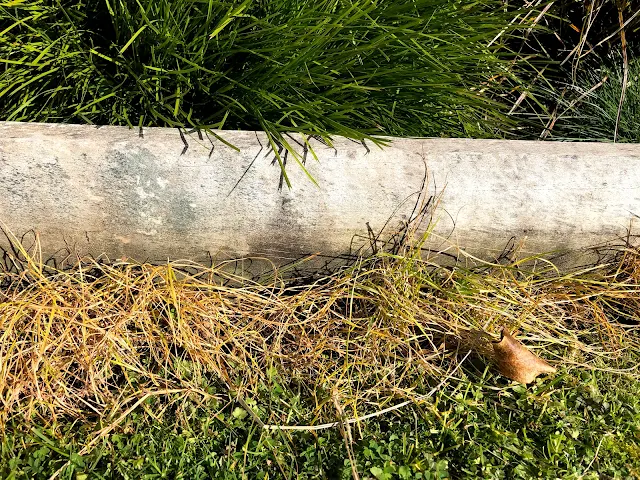🌿Using Glyphosate to Kill Weeds Effectively and Safely
Glyphosate, sometimes misspelled as "glyphosphate," is one of the most effective non-selective herbicides available to home gardeners. It works systemically, meaning it's absorbed through the leaves of a plant and travels all the way down to the roots, ensuring a complete kill of both grasses and broadleaf weeds. For decades, it has been a reliable tool for clearing stubborn patches, cleaning up driveways, and prepping garden beds.
The most recognizable name in the glyphosate game is Roundup, but the active chemical is what counts, and most generic formulas work just as well at a lower price. One important note: glyphosate is non-selective. That means if you hit your lawn, roses, or prized citrus tree, they’ll suffer just like the weeds. I learned that the hard way last summer when I mistook it for prickle spray. Lesson burned into my lawn and memory.
When applying, take care to avoid spray drift, especially near delicate shrubs, flower beds, or around young fruit trees.
🔬Why Is Glyphosate So Effective as a Weed Killer?
Glyphosate works at the biochemical level. It inhibits a specific enzyme pathway called the shikimic acid pathway, which is crucial for plant growth. Without it, the plant loses its ability to produce essential amino acids. Starved of nutrition, the plant yellows, wilts, and dies.
Unlike some herbicides that just burn the leaves, glyphosate travels through the entire plant system, all the way down to the roots. That’s why it’s so effective; it doesn’t just knock weeds down, it takes them out completely.
🛡How to Safely Use Glyphosate Around the Home
Used correctly, glyphosate is safe for home use. But like any chemical product, it deserves respect. The idea isn’t to fear it; it’s to handle it smartly. Here are some simple, commonsense precautions to follow when applying glyphosate-based herbicides:
Your Safety Checklist
- 🌬 Choose a still day with no wind to avoid spray drifting onto plants you want to keep alive.
- 👖 Wear long-sleeved clothing and trousers to limit skin exposure.
- 🧣 Use protective goggles, gloves, and a face mask, especially when spraying above waist height.
- 🌿 Never touch sprayed plants until they’re dry. Glyphosate takes time to be absorbed.
- 🛀 Once finished, remove gloves carefully and wash your hands, face, and forearms thoroughly. Shower if you’ve had direct contact or used a backpack sprayer.
❓How Long Does It Take for Glyphosate to Kill Weeds?
Glyphosate starts working immediately after it’s absorbed into the leaves, but you won’t see visible changes right away. Typically, signs of damage like wilting, yellowing, and leaf curl appear within 7 to 14 days. A complete kill, including root death, can take up to three weeks depending on the species and conditions.
For best results, apply glyphosate when the weather is warm and stable. Aim for temperatures above 60°F (15°C) and a clear forecast with no rain expected for at least 6-24 hours. This gives the herbicide time to fully absorb into the plant before being washed away.
💧How Do I Apply Weed Killer Like Glyphosate?
If you’ve got a big patch of thistles, couch grass, or wandering weed, a small bottle won’t cut it. Use a pump-action sprayer with a wand attachment. For targeted applications, like a crack in the pavement, go small with a handheld spray bottle. You can also use hose-end sprayers that mix automatically; just connect your hose, spray, and walk away.
🕑When Is the Best Time to Use Glyphosate?
Late spring through early autumn is prime time. Plants are actively growing, temperatures are ideal, and the results are fast. Avoid applying during extreme heat, just after rain, or when frost is likely. Moist soil helps uptake, but wet leaves dilute the spray.
🧪Who Discovered Glyphosate?
Glyphosate was originally synthesized in 1950 by Swiss chemist Henry Martin. It wasn’t until the 1970s that Monsanto chemist John Franz recognized its herbicidal potential. The rest is, quite literally, agricultural history, with glyphosate being marketed under the brand Roundup and its many generics.
🩺How Safe Is It to Use Glyphosate?
Glyphosate is approved for use in most countries under the oversight of regulatory agencies. In New Zealand, for example, the Ministry for Primary Industries maintains a detailed breakdown of its food and environmental safety. The short version: when used correctly, glyphosate poses minimal risk to humans. Despite public debate, the bulk of peer-reviewed science finds that glyphosate is unlikely to be carcinogenic at typical exposure levels. That said, it can be toxic to aquatic life and pollinators, so apply it precisely and keep it away from waterways and flowering plants.
🌱How Long Does Glyphosate Last in Soil?
One of glyphosate’s biggest strengths is that it doesn’t stick around in a biologically active form for long. It binds tightly to soil particles and is broken down by microbial activity over a few days to weeks. This means it won’t leach deep into groundwater or ruin your next planting season. You can safely spray weedy patches in late autumn and replant in spring without problems.
✅Final Thoughts: Use It Right, and Glyphosate Works
Glyphosate isn't a magic wand. It's a tool that can save you a whole lot of digging if used smartly. It works best when the timing, weather, and application are on point. And like any tool, it’s only as good as the care you take with it. Use the safety gear, avoid spraying in the wind, and read the label every time. Weed control takes patience; glyphosate just helps make the waiting worthwhile.



